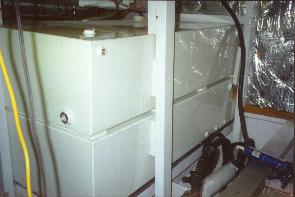Replacing Grand Banks Fuel Tanks
So, you have a tank problem… One of the most frustrating and expensive problems found in older Grand Banks is the problem of rusting fuel tanks.
 The problem of rusting fuel tanks
The problem of rusting fuel tanks
Face it, these tanks are enormous and expensive to remove. Many yards are actually cutting the sides or the bottom out of the boat to replace them. There is no reason to destroy the integrity of the hull to replace the tanks. We have found a way around this with a solution that should make any future problems much easier to deal with.
Fuel tank maintenance is usually caused by one of these four things:
- Too much heat created by not enough airflow in the engineroom. Excessive heat dries out the teak deck above the engine room and accelerates deck leaks. Running your blowers can reduce this effect and be an important part of your teak deck and therefore fuel tank preservation
- Deck condition deteriorates from a wide range of causes so that water drips on the top of the tank
- Fuel is left in the tank too long and moisture collects in the bottom
- Improperly coated. Tanks need a good epoxy coating to give a long life
 How can you tell if your tanks actually need replacing?
How can you tell if your tanks actually need replacing?
If your tanks are only rusting on the outside, you can probably repair them. Some flaking is not a severe problem as the metal on these tanks is substantially thick. As you can see on the right – this tank is rusting on the inside. In addition to the obvious leaking problem, you can expect to find continuous rust in your fuel.
The Removal
There is only one way to get these tanks out – perseverance, brute strength and lots of reciprocating saw blades. The tanks were removed in lots of pieces which were cut to a size small enough to handle. It was still necessary to remove the generator and obviously most of the fuel system. The old copper fuel lines have been replaced with top of the line Aeroquip hosing.
 Start with a good foundation.
Start with a good foundation.
While the tanks are out, it is a good opportunity to do some serious engine room clean up. The hull sides behind the tank were painted, the hoses and wiring checked, and everything made spotless. We used a base of solid PVC sheet for the tanks to rest on which is actually cheaper than painted plywood with the added benefit of being virtually non-permeable to diesel fuel and water. In this boat we replace a lot of the old acoustical soundproofing with a foil-faced lead lined sound insulation.
Installing the new tanks.

Our solution to the new tank replacement was to use four tanks instead of the standard two. Two tanks are stacked on each side with a large connecting hose joining each stack. The total capacity has not changed, but the smaller tanks are able to be brought in the boat through the hatch (and removed the same way if that need ever arises). Our tanks are rust-treated and Awlgripped for maximum longevity.
A good quality Grand Banks fuel tank replacement will require these key steps and associated equipment.
- Sawzall for smaller jobs
- Plasma cutting for larger tanks
- Great ventilation of the job site
- Safety considerations
- Repainting with epoxy
- Replacing the surrounding insulation
- Replacing exhaust hoses
Other Benefits
In the finished installation we are now able to access the tops of the tanks. Before there was only a few inches of clearance between the tank tops and the bottom of the deck. Now the tanks can be visually inspected and if any deck leaks occur they can be spotted and fixed with minor difficulties.
How to protect your tanks.
The best fix for tanks is prevention. Most tank rusting is caused by leaking deck fittings. The water has a tendency to run down the deck fill hose and pool out to the back of the tank where it is not visible. Once the paint on the tank has lost it’s adherence to the tank, the water will seep down under the paint and stay there. Interior rusting may be the result of the same leaking as above seeping into the tank through a loose fitting or by fuel contaminated by water. If you see water in your Racor, there is probably a lot more where that came from. Moisture in the tank can be controlled by fuel polishing, either with chemicals or with mechanical flushing systems.
We use new techniques for this job now. If you are not located in our area we do provide
consultations on tank jobs.

 How can you tell if your tanks actually need replacing?
How can you tell if your tanks actually need replacing? Start with a good foundation.
Start with a good foundation. Our solution to the new tank replacement was to use four tanks instead of the standard two. Two tanks are stacked on each side with a large connecting hose joining each stack. The total capacity has not changed, but the smaller tanks are able to be brought in the boat through the hatch (and removed the same way if that need ever arises). Our tanks are rust-treated and Awlgripped for maximum longevity.
Our solution to the new tank replacement was to use four tanks instead of the standard two. Two tanks are stacked on each side with a large connecting hose joining each stack. The total capacity has not changed, but the smaller tanks are able to be brought in the boat through the hatch (and removed the same way if that need ever arises). Our tanks are rust-treated and Awlgripped for maximum longevity.

 The problem of rusting fuel tanks
The problem of rusting fuel tanks
